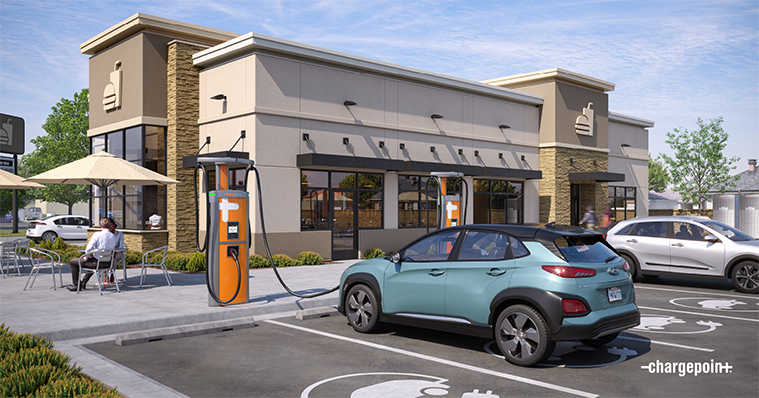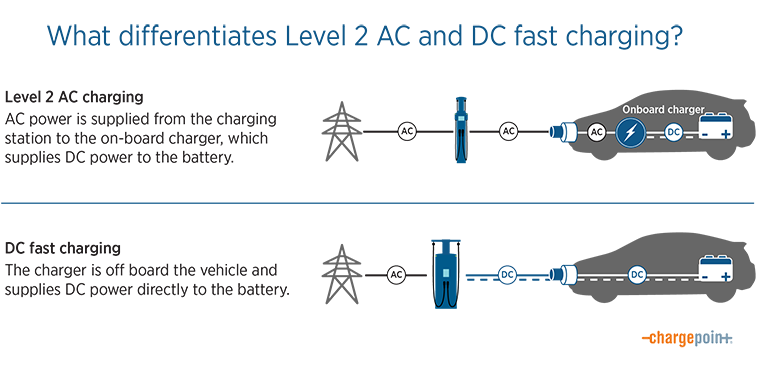
To perhaps state the obvious — ChargePoint DC fast chargers are faster than Level 2 AC charging stations. They are also just as easy to use as AC chargers. Like any Level 2 charging station, simply tap your phone or card, plug in to charge and then go on your merry way. The best time to use a DC fast charging station is when you need a charge right away and you’re willing to pay a little more for the convenience — like when you're on a road trip or when your battery is low but you are pressed for time.
Check out these tips for a great DC fast charging experience.
Tip: Not every electric vehicle (EV) is compatible with DC fast charging stations. If you think you’ll need a fast charge from time to time, make sure to ask about this option when buying your EV.
Check your connector type
DC fast charging requires a different type of connector than the J1772 connector used for Level 2 AC charging. Leading fast charging standards are SAE Combo (CCS1 in the U.S. and CCS2 in Europe), CHAdeMO and Tesla, as well as GB/T in China. More and more EVs are equipped for DC fast charging these days, but be sure to take a look at your car's port before you try to plug in.
ChargePoint DC fast chargers can charge any vehicle, but CCS1 in North America and CCS2 in Europe connectors are best for the maximum amperage, which is becoming standard in new EVs. Tesla EVs require a CCS1 adapter for fast charging with ChargePoint.
Here's what some common connectors look like:

Tip: You can filter by connector type in the ChargePoint app to find stations that work for your EV.
Save fast charging for when you need it most
Fees are usually higher for DC fast charging than for Level 2 charging. Because they provide more power, DC fast charging stations are more expensive to install and operate. Station owners generally pass some of these costs on to drivers, so it really doesn’t add up to use fast charging every day.
Another reason not to overdo it on DC fast charging: A lot of power flows from a DC fast charger, and managing it puts extra strain on your battery. Using a DC charger all the time could reduce your battery’s efficiency and lifespan, so it’s best to use fast charging only when you need it. Keep in mind that drivers who don't have access to charging at home or work may rely more on DC fast charging.
Follow the 80% rule
Every EV battery follows what’s called a “charging curve” when charging. Charging starts slow while your vehicle monitors your battery’s charge level, the weather outside and other factors. Charging then climbs to peak speed for as long as possible and slows down again when your battery has reached about an 80% charge to prolong battery life. (Check out this post and this post to learn more about charging curves.)
With a DC fast charger, it’s best to unplug when your battery reaches about 80% charged. That’s when charging slows dramatically. In fact, it could take almost as long to charge the last 20% as it did to get to 80%. Unplugging when you reach that 80% threshold is not only more efficient for you, it’s also considerate to other EV drivers, helping ensure that as many people as possible can use available fast charging stations. Check the ChargePoint app to see how your charge is going and to know when to unplug.
Did you know? With the ChargePoint app, you can see the rate at which your car is charging in real time. Just click on Charging Activity in the main menu to see your current session.

AC vs. DC
Finally, if you’ve ever wondered why it’s called “DC fast charging,” the answer is simple. “DC” refers to “direct current,” the type of power that batteries use. Level 2 charging stations use “AC,” or “alternating current,” which you’ll find in typical household outlets. EVs have onboard chargers inside the car that convert AC power to DC for the battery. DC fast chargers convert AC power to DC within the charging station and deliver DC power directly to the battery, which is why they charge faster.
Our ChargePoint Express and Express Plus stations provide DC fast charging. Search our charging map to find a fast charging spot near you.

